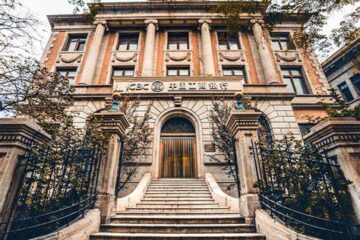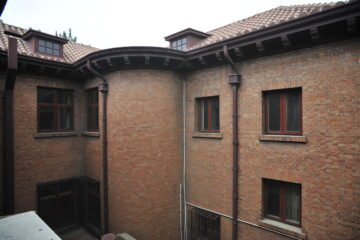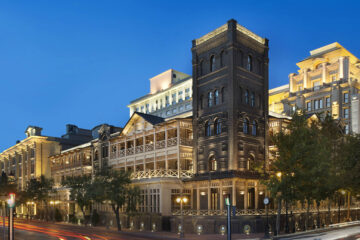Minyuan Sports Stadium
建筑简介:位于天津五大道核心区,椭圆形场地
Architectural Introduction: Located in the core area of Tianjin Wudao, with an oval shaped site
小楼故事:天津的五大道原本是城南的一片荒芜的泥沼洼地,1918年英国租界工部局在这片新建的住宅区中间留下了这块空地,8年后为满足英国侨民的体育需求,把天津原来墙子河的河泥挖出,通过“吹泥填地”的办法,将这片备用地填平并重新规划,在上面建起了这个占地41200平方米的体育场,取名民园国际运动场。初建的民园体育场里跑道长500米,周边围有简易的铁栅栏,西侧安置有约100米长的看台。当时奔跑在赛道上的英国侨民中有一位出生在天津的英籍中学教师李爱锐(1902-1945).在1924年巴黎奥运会上他曾以47秒6的成绩取得了400米的金牌并打破世界纪录,这一记录此后保持了35年。因此有人猜想李爱锐也许对1926年建成的民园体育场提出过设计意见。1929年旧英租界当局在民园体育场举办了一场万国田径赛,28岁的李爱锐取得了400米金牌,这也是他体育生涯最后的一块金牌。李爱锐冲刺时的仰头挺胸的招牌动作也被复制到以他真实故事改编的电影《烈火战车》中,1982年这部体育片拿下了第54界奥斯卡金像奖的最佳影片而名垂影史。1937年日本发动侵华战争,为了避免被空袭,民园广场被喷上了一面巨大的英国国旗,直至1941年被日军占领后被除去。两年后日军还拆除体育场铁栅栏和铁门用于制造军火,民园的围墙改为砖墙,跑到也缩减为400米。新中国成立后,1954年民园体育场迎来了一次大规模改建,足球场地由沙地改为草坪,四角搭建起24米高的木质灯架,中国的第一座等过球场由此成型。此后1980年天津足球拿下首个全国冠军后愈战愈勇,拥有一批铁杆球迷,那时的民园体育场拥有13个出入口,能容纳两万人观赛,标志性的高架灯光塔高达48米,电子记分牌、塑胶跑道等现代化体育设施书写着天津体育的历史。2012年由于设施陈旧民园体育场退出赛事的历史舞台,2014年修整后的民园集休闲娱乐、商业文化于一体。2014年9月来自90多个国家的1600余名职业经理人、经济学专家、国家和地区领导人以及财经类媒体人出席了这场夏季达沃斯文化晚宴,也再次将世界的目光拉回来天津民园的这片椭圆形场地。
Story of Xiaolou: The Five Avenues in Tianjin were originally a barren swamp in the south of the city. In 1918, the British Concession Works Bureau left this vacant land in the middle of this newly built residential area. Eight years later, in order to meet the sports needs of British expatriates, they dug out the mud from the original Qiangzi River in Tianjin, filled it with “blowing mud to fill the land”, and re planned this reserve land. A 41200 square meter sports stadium was built on top of it, named Minyuan International Sports Ground. The newly-built Minyuan Sports Stadium has a running track of 500 meters, surrounded by a simple iron fence, and a grandstand of about 100 meters on the west side. At that time, there was a British high school teacher named Li Airui (1902-1945) born in Tianjin among the British expatriates running on the track At the 1924 Paris Olympics, he won the gold medal in the 400 meter race with a time of 47.6 seconds and broke the world record, which was held for 35 years thereafter. Therefore, some speculate that Li Airui may have provided design suggestions for the Minyuan Sports Stadium built in 1926. In 1929, the authorities of the former British Concession held a world athletics competition at the Minyuan Sports Stadium, and 28 year old Li Airui won the gold medal in the 400 meter race, which was also his last gold medal in his sports career. The signature action of Li Airui’s head up and chest up during the sprint was also replicated in the movie “Chariots of Fire” adapted from his true story. In 1982, this sports film won the Best Picture award at the 54th Academy Awards and became famous in film history. In 1937, Japan launched the War of Aggression against China. In order to avoid being bombed, a huge British flag was sprayed on Minyuan Square until it was removed after being occupied by the Japanese army in 1941. Two years later, the Japanese army also dismantled the iron fences and gates of the sports stadium for the production of weapons, changed the walls of the civilian park to brick walls, and reduced the distance to 400 meters. After the establishment of the People’s Republic of China, the Minyuan Sports Stadium underwent a large-scale renovation in 1954. The football field was converted from sandy land to a lawn, and 24 meter high wooden light frames were erected at the four corners. This marked the formation of China’s first waiting field. After winning the first national championship in 1980, Tianjin Football became more and more brave, with a group of loyal fans. At that time, the Minyuan Sports Stadium had 13 entrances and could accommodate 20000 spectators. The iconic elevated light tower was 48 meters high, and modern sports facilities such as electronic scoreboards and plastic tracks wrote the history of Tianjin sports. In 2012, due to outdated facilities, the Minyuan Sports Stadium withdrew from the historical stage of the competition. In 2014, the renovated Minyuan integrates leisure, entertainment, commercial and cultural activities. In September 2014, more than 1600 professional managers, economics experts, national and regional leaders, and financial media from over 90 countries attended the Summer Davos Cultural Dinner, once again drawing the world’s attention back to the elliptical venue of Tianjin Minyuan.



0 条评论